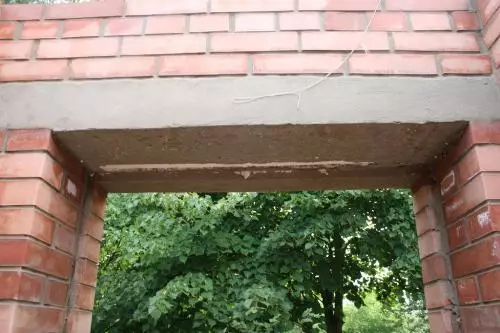
In fact, it is not difficult to make jumpers yourself at all, and the savings are significant - you need to pay only for materials, and they are known to cheaper than the finished product. On how to make jumpers yourself, and it will be discussed below.
To begin with, consider the basic types of jumpers and cases of use:
- carrying jumpers - beams reinforced (used) - are used to perceive the loads from the slabs of the overlap;
- nonsense - beams (b) - perceive only the load from the wall laying over the opening;
- Pencils - thin non-vacuum jumpers, which are used in the doorways of interior partitions with a thickness of 120 mm;
- Rams - carrying lintels of large sizes;
- Rigel - runs with a shelf, which is the basis for the emphasis of higher structures.
The most common are carrying and non-vacant jumpers, which are used for window and doorways. The technology of their manufacturing and consider further.
Jumpers for window and doorways do it yourself
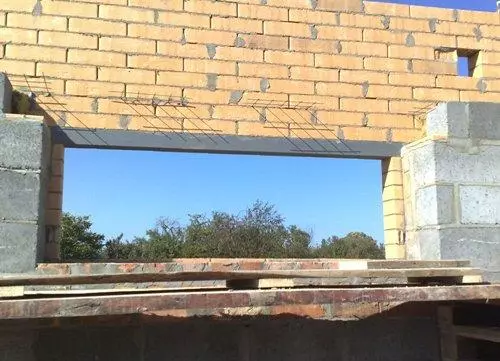
So, before proceeding with the manufacture of jumpers, you need to determine their appearance. For small houses with a lightweight roof design, you can use nonsense jumpers, which will provide additional savings. Also "Bishki" can be used in cases where the slabs of overlapping all existing floors are based on the reinforced belt. Such belts themselves perceive the loads and distribute them evenly.
Consider the technology of manufacturing jumpers. First you need to make a jumper for facial masonry, the role of which will play the corner. Typically, angle is 100 mm, but not less than 75 mm. The corner is installed in such a way that its vertical regiment is not outside, but between the facial and undercover masonry, then it will not be noticeable. Rib Corner need to be located in a quarter quarter. This will allow tightly press the window when installing it without the formation of cracks and gaps. The magnitude of the window quarter is 50 mm.
Article on the topic: How to make a gazebo of polycarbonate: photos, video, drawings
Now consider two embodiments of the jumper: its fill directly above the opening or on the ground, followed by the installation in the opening. What option is better? There is no fundamental difference. In the first case, you will have to tinker with the installation of formwork, in the second - raise and install the finished jumper manually. The second option is heavier, because it is not always possible to hire a crane for lifting the jumper. Also in this case, you will need to make two jumpers on the window of 150 mm wide each (the thickness of the undercover masonry is 300 mm: foam block and 100 mm insulation).
If you give preference to the first option - the pouring of the jumpers in the opening can be saved not only forces, but also time, and money. An important advantage is that with this manufacturer, the jumper will be only one, and not two, as in the second version. True, the installation of the formwork can cause a number of questions, because it should not only be securely secure, but also to hold inside a sufficiently heavy concrete.
Formwork under the jumper
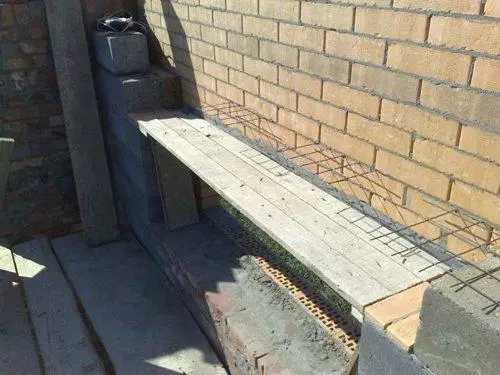
The formwork is made from wooden boards, the thickness of which is 20-25 mm, of which shields are manufactured. Between the boards are attached to nails or self-drawing. It is better to use selflessness and quickly screwing them with a screwdriver. Then the formwork will also easily disassemble, twisting them.
First, the horizontal shield, resting on the backups, is installed in the opening. It can be placed in a slope with a suction masonry or lightly go beyond its limits. In the second case, the vertical shield will be installed on top of it, and not on the side.
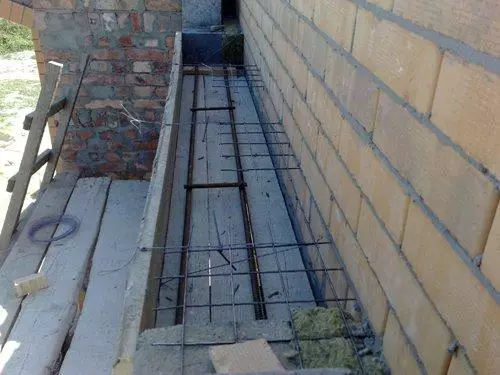
A reinforcement grid is laid out on the formwork on the horizontal shield, and then the vertical shield is fixed with self-draws. For better fixation of the vertical shield when pouring it, it can be additionally tied to a masonry grid knitted wire and pull it out. It prevents the movement of the shield under the action of the load from the concrete, and it will fit tightly to the window.
Warming jumper
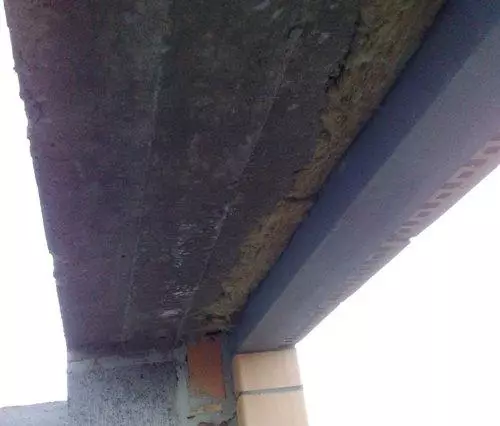
It is necessary to make a thermal layer between facial masonry and jumper. To do this, you can use mineral wool, as in the case of wall insulation. Heater thickness - 100 mm. Mineral wool is laid in formwork, after which concrete is poured.
Article on the topic: We make a podium for the shower cabin with their own hands
The insulation of the jumper using mineral wool has a disadvantage - a window that will be installed in the opening, it will restorate to the surface of the wool, and even the filling of the joint foam will not give one hundred percent fixation of the window frame. The slopes of the window opening when using mineral wool, you need to lay down the incortocrous brick so that the window and securely fixed in it using the mounting foam. If this is not done, the foam again will be in contact with the cotton, without providing the desired mounting of the window design. But when using a suction masonry on the slopes will have to warm them again.
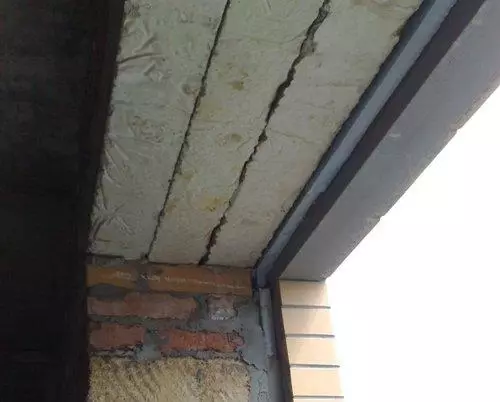
In order not to create yourself unnecessary problems and not duplicate the insulation layer, you can immediately use a simpler and reliable way of insulation of the jumper. As a heater, instead of mineral wool, an extruded expanded polystyrene was used - Pumppan - which, unlike wool, has a sufficiently strong surface. Pumpana sheet thickness - 30 mm. When mounting the window, the gap between the frame and the insulation is filled with foam, which rests on the solid surface of the Pumpana sheet and reliably fixes the window in the opening. Additional layer of insulation in this case is not necessary. Thus, when using a solid insulation, you can save on the insulation of slopes and get a reliable mounting of the window.
Reinforcement of jumper
The diameter of the reinforcement for the jumper depends on its type. In this case, "Bishka" was chosen, which perceives the minimum of loads and is undesigious. Such a choice was made due to the presence of a reinforced belt and lightweight roof design. For such a jumper, the reinforcement grid of two veins of reinforcement is suitable, the diameter of which is 6-8 mm. Working reinforcement is laid along the jumper. Between the rods of the reinforcement should be fastened by knitting with knitting wire. Welding for their connections is not used. As a result, the mesh should be obtained, which looks like an appropriate staircase.Strengthening formwork by backups
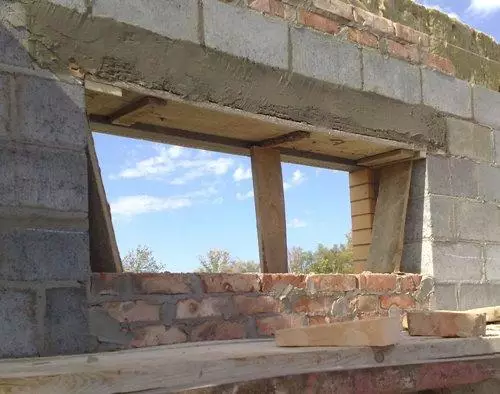
When installing the horizontal shield, the formwork must be used backups. Some builders do not make this without taking into account the rather significant weight of concrete, which is about 2.5 t / m3. When pouring the solution in the formwork, it can shift the shield or deform it, having rushing down. It will definitely affect the shape of the jumper, and it will be fixed very hard. So it is better to immediately take care of a reliable formwork and its tough design.
Article on the topic: Garage lifting gates: Prices from manufacturers and type review
When fixing the backup, located in the center of the opening, it needs to be located closer to the window. The inner edge will not be saved because it is attached to the vertical shield.
Pouring reinforced concrete jumper with their own hands
For the pouring of the jumper, concrete brand 200 is used. For its manufacture, it will take cement, sand and crushed stone in proportions, respectively 1: 2: 5. On the technology of making concrete can be found on the pages of our site.
In the manufacture of concrete structures, electric vibrators are used for their traaming. In this case, you can do without additional techniques. For a rambling, you can use a simple stick.
When pouring, the reinforcement should be slightly raised over a horizontal shield to subsequently be completely recessed in concrete, without looking out. To do this, under the reinforcement grid, it is possible to put the chips of bricks with a thickness of 20 mm, and already pour a concrete solution.
After filling, the formwork can be dismantled on the second day and immediately begin to lay the wall over the formwork.
The window must have a quarter. Such a constructive solution will allow to protect the inner premises from the fall of cold air and the occurrence of drafts, as well as hide the slots filled with the mounting foam. The sizes of the quarter are 5 cm on the sides of the window and from above, and from the bottom where the windowsill will be mounted - 2 cm. Make it is quite simple, but at the same time, many have recently come out without it. And yet, if you have a choice, it is better to make a quarter on the window - this is not only beautiful, but also practical.
So, summarize.
First, jumpers need to be chosen depending on the loads that they perceive. It is better to pour them immediately in the opening, and not on earth - it will save money and time.
Secondly, the windows are best done with a quarter.
Thirdly, the jumpers for window and doorways are better to choose the most simple - nonsense. For this you need to take care of the presence of reinforced belts and the maximum easy structural elements.
